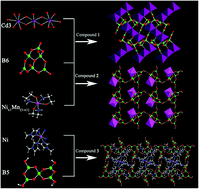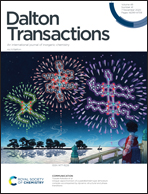Trinuclear Cd3O14 hexaborate and two nickel borates based on molten salt synthesis and precursor synthesis: structure, characterization, and properties†
Abstract
In this work, different synthetic methods were used to prepare metal borates. One cadmium borate Cd3[B6O9(OH)2]2·2NO3·4H2O (1) and two nickel borate Ni0.8Mn0.2{B6O7(OH)3[O(CH2)2NH2]3} (2), [Ni(1-MI)6]·[B5O6(OH)4]2·2DMF (3, 1-MI = 1-methylimidazole, DMF = N,N-dimethylformamide) species were successfully prepared. The structures of these three compounds were confirmed via single crystal powder X-ray diffraction (SCPXRD), elemental analysis, FTIR, PXRD, and ICP studies. Compound 1 was prepared via molten salt synthesis, and compounds 2 and 3 were prepared via precursor synthesis, which is a synthetic method that uses a certain polyanionic cluster as a reagent. Compound 1 shows a novel three-dimensional (3D) structure, in which the [B6O11(OH)2] units acting as the basic polyanionic cluster form a two-dimensional (2D) anionic structure. In addition, the unexpected Cd3O14 clusters are connected with the 2D structures, leading to the 3D structure. The crystal structure of 2 is packed with very large neutral Ni0.8Mn0.2{B6O7(OH)3[O(CH2)2NH2]3} oxo-metal–boron clusters. The crystal structure of 3 consists of a [B5O6(OH)4]− cluster, a DMF molecule, and a [Ni(1-MI)6]2+ complex. In particular, 2 was successfully constructed using the same hexaborate cluster as its precursor. However, 3 only contains Ni2+ cations when a neutral NixMn1−x[B6O7(OH)6] cluster was used as an initial reagent, and it shows an ability to select a certain metal cation during the self-assembly process. Moreover, compounds 1, 2, and 3 exhibit different wide band gaps of 3.06 eV (1), 3.95 eV (2), and 4.24 eV (3).



 Please wait while we load your content...
Please wait while we load your content...